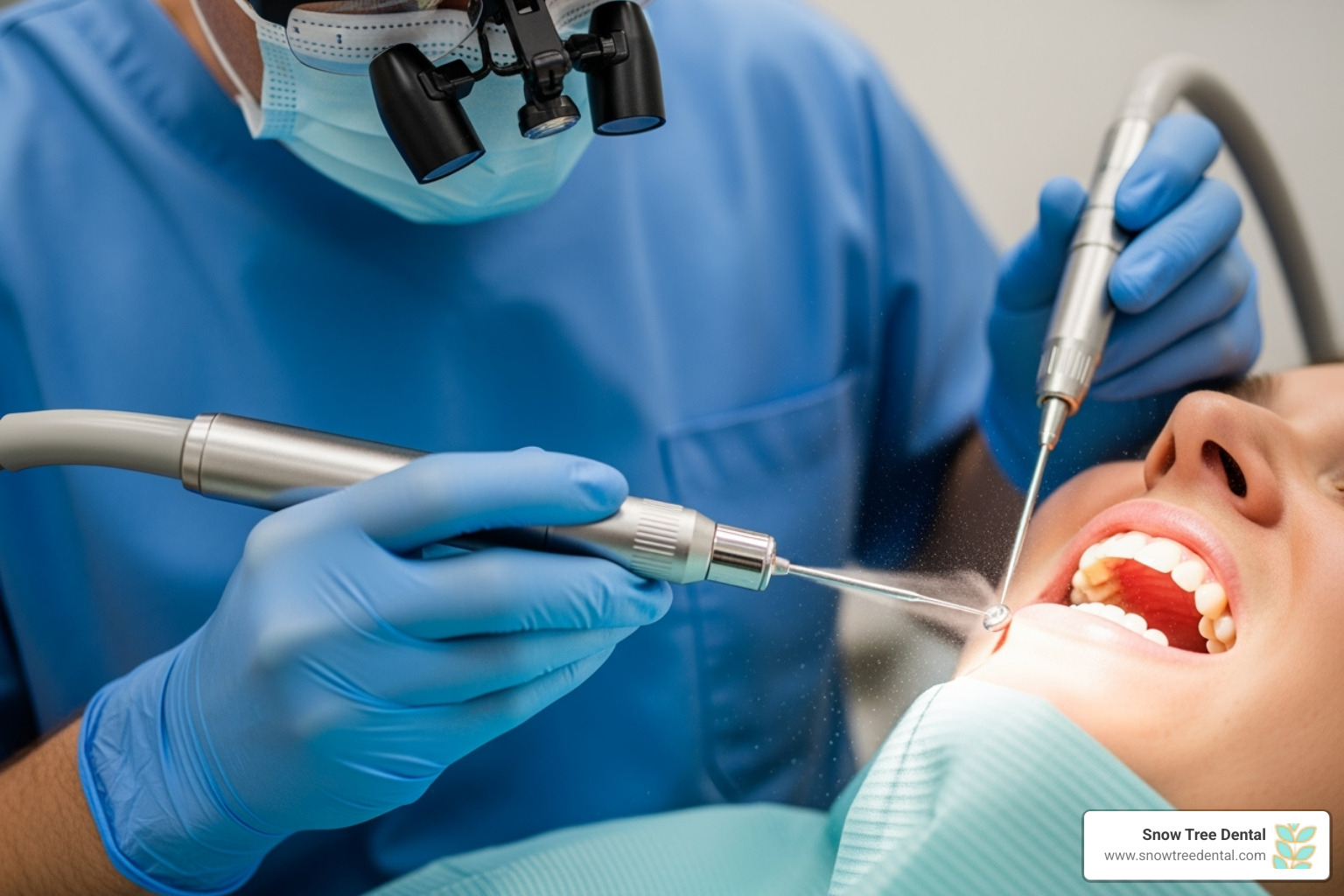Periodontal disease treatment: Best Gums 2025
Why Early Periodontal Disease Treatment Can Save Your Smile
Periodontal disease treatment ranges from simple cleanings for early gingivitis to advanced surgery for severe periodontitis. Your main options include:
Non-Surgical Treatments:
- Professional dental cleaning
- Scaling and root planing (deep cleaning)
- Antibiotic therapy
Surgical Treatments:
- Flap surgery (pocket reduction)
- Bone grafting
- Soft tissue grafts
Key Facts:
- Gingivitis is reversible with proper treatment.
- Periodontitis is manageable but not curable.
- Early treatment prevents tooth loss.
Seven in ten Canadians will experience gum disease, and nearly half of all U.S. adults have some form of it, making it the leading cause of tooth loss. The good news is that gum disease is largely preventable and highly treatable when caught early.
Understanding your treatment options is the first step toward restoring your oral health. At Snow Tree Dental, Dr. Muna Mohammad helps Houston families steer periodontal disease treatment with personalized care plans. Our approach combines modern dental techniques with a focus on patient comfort, ensuring you receive effective treatment while feeling at ease.
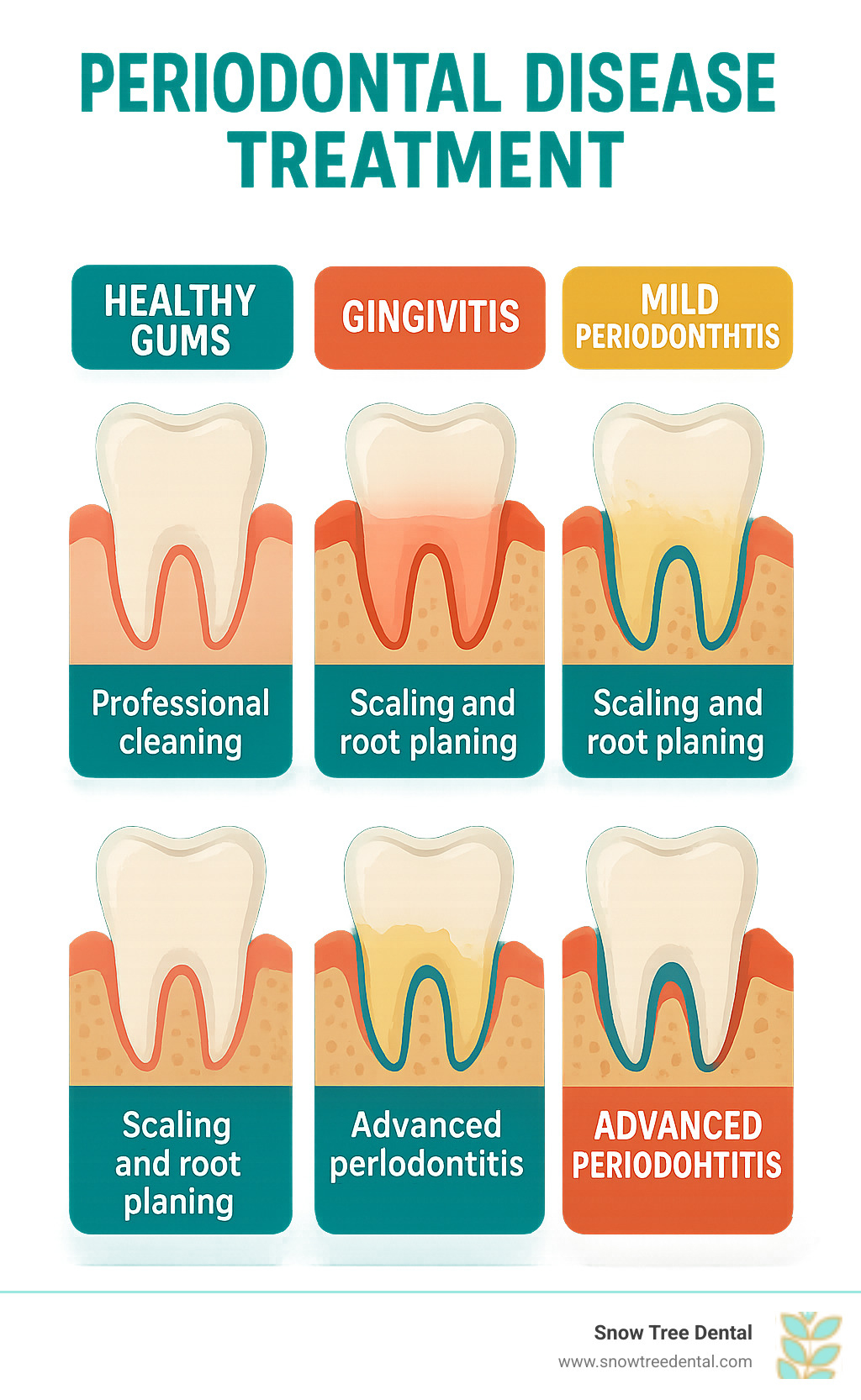
Understanding Periodontal Disease: From First Signs to Diagnosis
Periodontal disease is a serious gum infection that damages the soft tissues and bone supporting your teeth. What begins as minor irritation can progress to tooth loss and even affect your overall health. Fortunately, understanding the disease allows you to take action before it’s too late.
What are the Stages of Gum Disease?
Knowing the stages of gum disease helps determine the best periodontal disease treatment for you.
Gingivitis is the earliest stage, caused by plaque buildup. This sticky film of bacteria hardens into tartar if not removed, irritating the gums. This causes them to become red, swollen, and bleed during brushing. While many people ignore bleeding gums, it’s a clear sign your gums need help. The good news is that gingivitis is completely reversible with good oral hygiene and a professional cleaning.
Periodontitis is the more serious stage that develops from untreated gingivitis. The infection spreads below the gum line, causing gums to pull away from the teeth and form pockets. These pockets trap more bacteria, which destroy the bone and ligaments holding your teeth in place. You might notice loose teeth, a change in your bite, or persistent bad breath. Unlike gingivitis, damage from periodontitis is irreversible, but it can be managed with proper periodontal disease treatment to prevent it from worsening.
| Feature | Gingivitis | Periodontitis |
|---|---|---|
| Reversibility | Reversible with good oral hygiene and cleaning | Not curable, but manageable; damage is irreversible |
| Involvement | Gums only; no bone or tissue loss | Gums, bone, and supporting tissues; bone loss occurs |
| Symptoms | Red, swollen, bleeding gums | Receding gums, loose teeth, persistent bad breath, pus, painful chewing, deep pockets |
| Treatment Goal | Eliminate inflammation, restore gum health | Halt disease progression, prevent further damage, manage symptoms, preserve teeth |
Common Symptoms and Causes
Pay attention to your mouth’s warning signs, even if they seem subtle.
- Bleeding gums: The first red flag. Healthy gums should not bleed.
- Swollen or tender gums: Gums that look puffy or feel sore.
- Persistent bad breath: An unpleasant odor caused by bacteria.
- Pus between teeth and gums: A sign of active infection.
- Receding gums: Makes teeth appear longer.
- Loose teeth or changes in bite: Indicates loss of support.
- Painful chewing: Can make eating uncomfortable.
The main cause is bacteria in dental plaque. Poor oral hygiene is the leading reason for plaque buildup, but other factors can contribute.
Risk Factors and Systemic Health Links
Certain factors increase your risk for periodontal disease.
- Smoking and tobacco use: Weakens the immune system and masks bleeding, a key symptom.
- Diabetes: Increases susceptibility to infections, and gum disease can make blood sugar harder to control.
- Hormonal changes: Puberty, pregnancy, or menopause can make gums more sensitive.
- Genetics: Some people are more predisposed to gum disease.
- Other factors: Chronic stress and certain medications that cause dry mouth can also play a role.
Gum disease isn’t just an oral issue. The link between gum disease and overall health is well-established. Bacteria from gum infections can enter the bloodstream and contribute to heart disease, stroke, respiratory infections, and diabetes complications. It has also been linked to preterm birth, rheumatoid arthritis, and Alzheimer’s disease. Treating gum disease is crucial for protecting your overall health.
How Dentists Diagnose Periodontal Disease
At Snow Tree Dental, we perform a gentle, thorough evaluation to create an effective treatment plan.
We start by reviewing your medical history and symptoms. Then, during the mouth examination, we check for inflammation, swelling, and bleeding. The key diagnostic step is measuring pocket depth with a periodontal probe. This painless process measures the space between your tooth and gum. Healthy pockets are 1-3 mm deep; pockets deeper than 4 mm often indicate periodontitis.
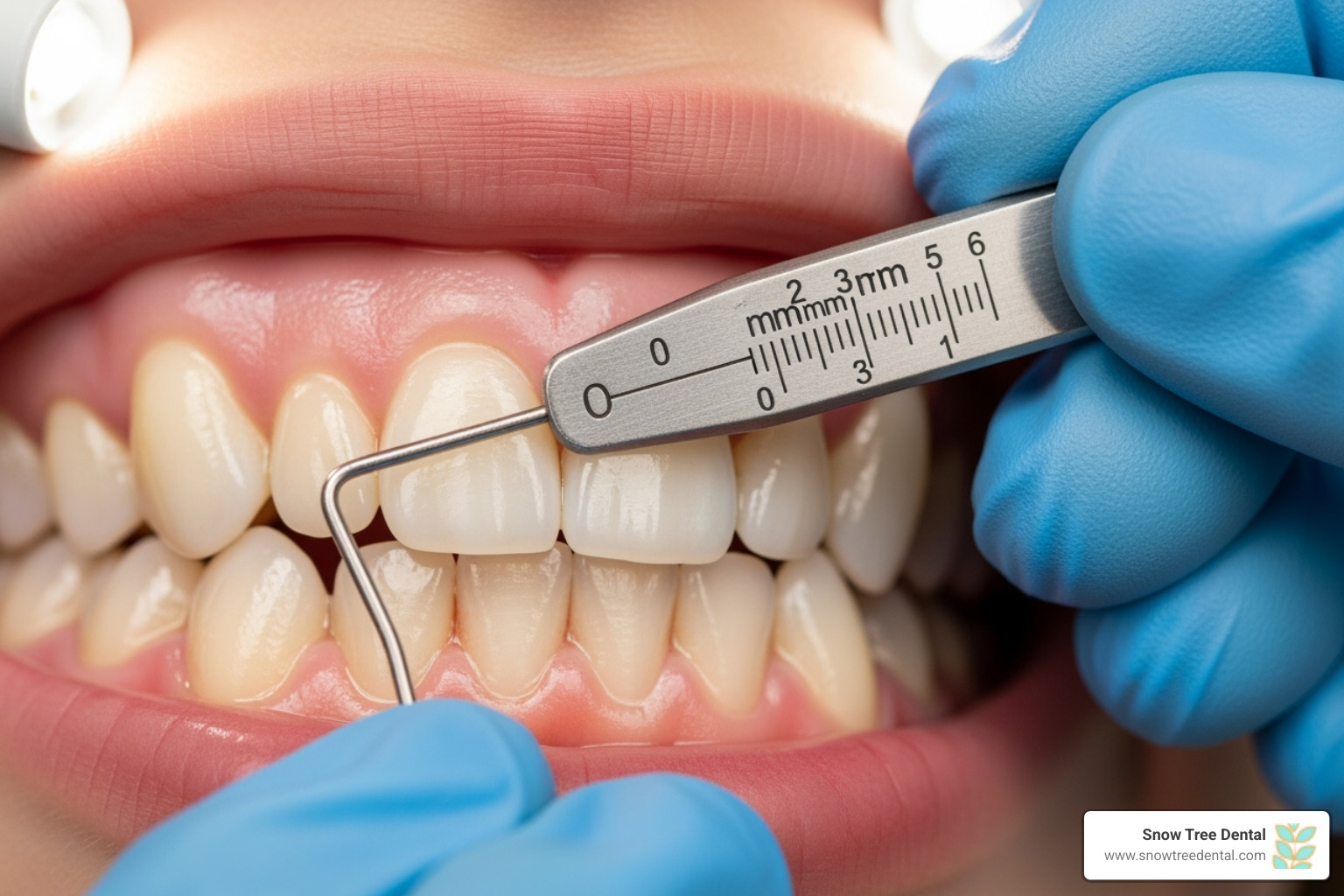
Dental X-rays allow us to see bone loss around the teeth that isn’t visible otherwise. Based on these findings, we determine the stage and grade of your condition, which helps us recommend the most appropriate periodontal disease treatment. To learn more about our comprehensive approach, visit our General Dentistry services page.
Your Guide to Non-Surgical Periodontal Disease Treatment
Once we identify the stage of your gum disease, we can create your personalized periodontal disease treatment plan. Many patients, especially in the early stages, respond well to non-surgical treatments. These methods focus on controlling the bacterial infection and stopping further damage without surgery.
Professional Dental Cleaning
If you have gingivitis, a professional dental cleaning may be all that’s needed to restore your gum health. This early stage of gum disease is completely reversible. Our hygienists will gently remove all plaque and tartar from above and just below your gum line. With the bacteria gone, inflammation subsides, and many patients see healthier gums within days.
Scaling and Root Planing (Deep Cleaning)
For periodontitis, we often recommend scaling and root planing, or a “deep cleaning.” This is a highly effective first step in periodontal disease treatment for this stage.
- Scaling: We carefully remove plaque and tartar from above and below the gum line, reaching deep into the periodontal pockets.
- Root Planing: We smooth the tooth roots to help the gums reattach and to prevent bacteria from accumulating again.
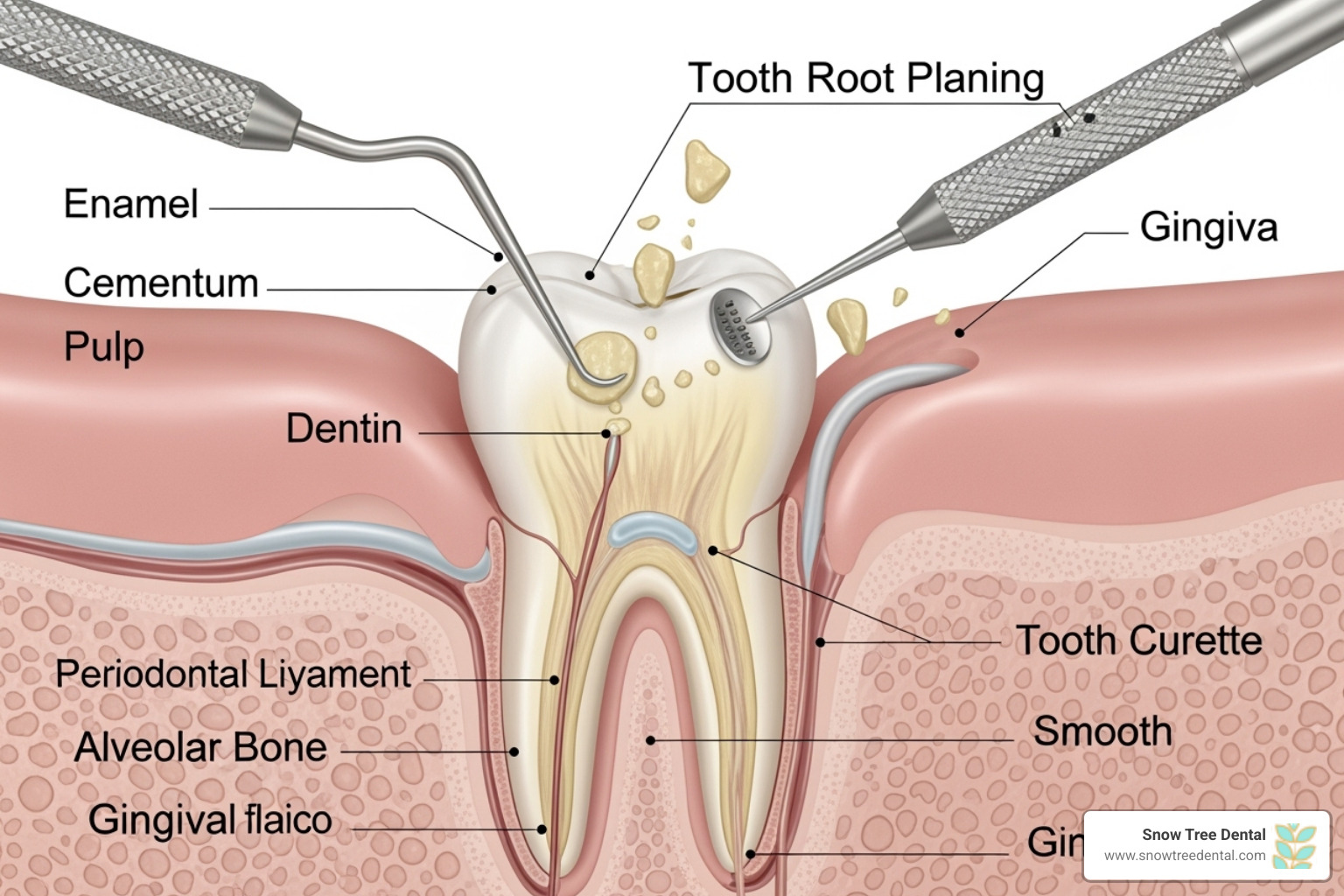
We use a local anesthetic to ensure your comfort throughout the procedure. For many patients, this treatment alone is enough to achieve excellent periodontal health. The American Academy of Periodontology offers more details on non-surgical options.
Antibiotic and Medication-Based Therapies
To improve the results of cleaning procedures, we may incorporate medications into your periodontal disease treatment plan. These therapies help control bacterial infection and reduce inflammation.
- Topical antibiotics like gels or antiseptic chips are placed directly into periodontal pockets to target the infection at its source.
- Oral antibiotics may be prescribed for more widespread infections to help your body fight the bacteria systemically.
- Enzyme suppressants are low-dose medications that can help control your body’s inflammatory response, preventing the breakdown of gum tissue.
These therapies, combined with professional cleaning, give your mouth the best chance to return to health.
Advanced Surgical Options for Periodontitis
When non-surgical treatments are not enough to control advanced gum disease, surgical options become the next line of defense. These procedures are key to saving teeth and restoring oral health by halting disease progression and repairing damage. At Snow Tree Dental, we work closely with trusted periodontists (gum specialists) to ensure you receive the most appropriate care.
Flap Surgery (Pocket Reduction Surgery)
When periodontal pockets are too deep to clean effectively (typically over 5 millimeters), flap surgery is recommended. This periodontal disease treatment allows for a more thorough cleaning.
During the procedure, the gums are gently lifted back, providing direct access to remove tartar and diseased tissue from deep pockets and root surfaces. If needed, the underlying bone is reshaped to eliminate areas where bacteria can hide. Finally, the gums are sutured snugly back around the teeth. This reduces pocket depth, making it much easier for you to keep the area clean at home.
Regenerative Procedures: Bone and Gum Grafts
When periodontal disease has destroyed bone or gum tissue, regenerative procedures can help rebuild what was lost. These advanced surgical treatments can restore the foundation supporting your teeth.
- Bone Grafting: If you’ve lost bone, we can place grafting material (from your own body, a donor, or synthetic sources) into the affected areas. This material acts as a scaffold, encouraging your body to grow new, healthy bone. Sometimes, a special barrier (guided tissue regeneration) is used to ensure bone grows properly without interference from faster-growing gum tissue.
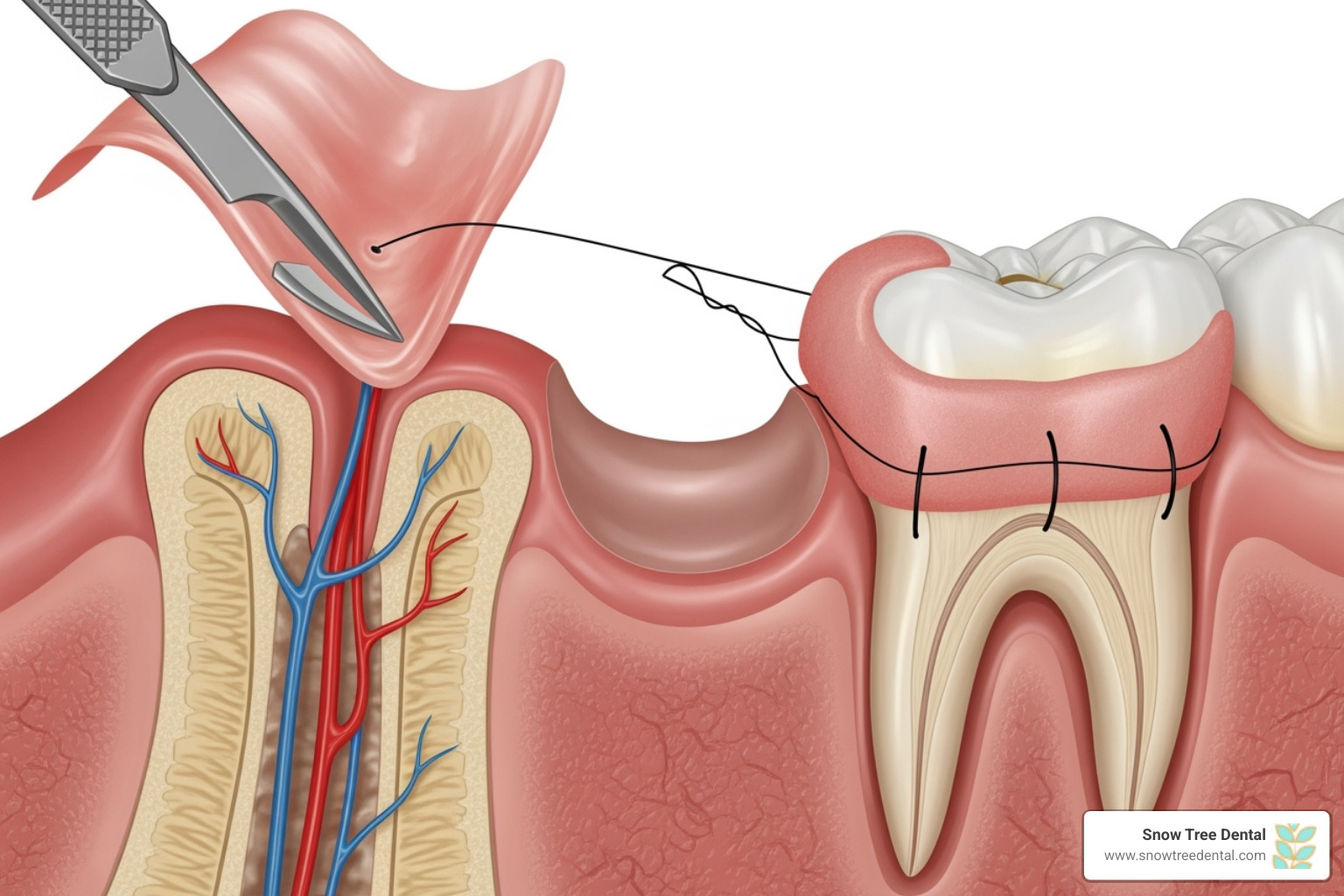
- Soft Tissue Grafts: When gums recede and expose sensitive tooth roots, a gum graft can cover these areas. We typically use a small piece of tissue from the roof of your mouth or a donor source and attach it where the gums have pulled away. This reduces sensitivity and protects the roots.
Other regenerative techniques may involve using tissue-stimulating proteins or platelet-rich plasma (PRP) from your own blood to accelerate healing. The field of regenerative periodontal disease treatment is constantly evolving, with research on regenerative procedures showing promising results for restoring both function and aesthetics.
Prevention and Long-Term Management
Successful periodontal disease treatment is a major victory, but it’s the beginning of a lifelong commitment to gum health. Ongoing care is essential to prevent the disease from returning.
What to Expect After Your Periodontal Disease Treatment
After treatment, your gums should stop bleeding, swelling should decrease, and your mouth will feel healthier. However, the bacteria that cause gum disease can return within months if not managed. This is why follow-up care is critical.
Periodontal maintenance cleanings become your new normal. These specialized appointments, usually every three to six months, are different from regular cleanings. We focus on cleaning deeper gum pockets and monitoring your gum health to catch any issues before they escalate. Your commitment to this ongoing care is the key to keeping your smile healthy for years.
Can Periodontal Disease Be Cured?
This is a common and important question. The answer depends on the stage of the disease.
- Gingivitis is completely reversible. With proper treatment and home care, your gums can return to perfect health.
- Periodontitis is manageable, not curable. Once bone and tissue damage has occurred, it cannot be fully reversed. However, we can effectively stop the disease, control the infection, and prevent further damage. Think of it like managing a chronic condition like diabetes. With consistent care, you can maintain excellent oral health and keep your natural teeth for decades.
How to Prevent Gum Disease at Home
Your daily habits are your most powerful tool for prevention.
- Proper Brushing: Brush twice a day for two minutes with a soft-bristled toothbrush angled toward the gum line. Electric toothbrushes are often more effective.
- Daily Flossing: This is non-negotiable. Floss reaches where your toothbrush can’t. Use traditional floss, interdental brushes, or a water flosser daily.
- Antimicrobial Mouthwash: If recommended, use it to supplement your brushing and flossing routine.
- Balanced Diet: A diet rich in vitamins and minerals supports your immune system. Limit sugary foods and drinks that feed plaque-causing bacteria.
- Quit Smoking: Tobacco use is a major risk factor for gum disease and hinders healing. Quitting is one of the best things you can do for your gums.
Regular dental check-ups are also crucial for removing tartar and catching early warning signs. At Snow Tree Dental, we believe in empowering you with knowledge. Learn more about our Preventative Dentistry services.
Frequently Asked Questions about Periodontal Disease
We understand you may have more questions. Here are straightforward answers to some common concerns.
When should I see a dentist for gum problems?
If you’re wondering, you probably should. See a dentist immediately if you notice bleeding, swollen, or tender gums, or have persistent bad breath. These are early warning signs. More advanced symptoms like receding gums, loose teeth, or pus require urgent attention. Early periodontal disease treatment is simpler and more effective. At Snow Tree Dental, we offer flexible scheduling, including evening, Saturday, and same-day emergency appointments, because your health can’t wait.
What is the role of a periodontist in treating gum disease?
A periodontist is a dentist who has completed up to three additional years of training specializing in the gums and supporting structures of the teeth. While your general dentist handles most treatments like cleanings and scaling and root planing, a periodontist is an expert in more complex or severe cases. They perform advanced surgical procedures like flap surgery, bone grafts, and gum grafts, and are also experts in placing dental implants.
How long can you keep your teeth with periodontal disease?
With early diagnosis, proper periodontal disease treatment, and consistent maintenance, many people keep their natural teeth for a lifetime. The key factors are how early the disease is caught and your commitment to your home care and maintenance schedule. Untreated periodontal disease is the leading cause of tooth loss in adults, so taking action quickly makes a huge difference in your long-term prognosis.
Conclusion: Taking the Next Step Towards Healthy Gums
Your smile is worth fighting for, and now you have the knowledge to do it. We’ve covered how gum disease starts with reversible gingivitis and can progress to manageable periodontitis. Modern periodontal disease treatment can stop the disease at any stage, but taking action early is key.
Proactive oral care is critical. At Snow Tree Dental, we use modern technology to make your treatment comfortable and efficient. Our approach is built around your family’s needs, with flexible scheduling, including evening, Saturday, and same-day emergency appointments. We also offer transparent pricing and an in-house dental plan to make quality care accessible.
Investing in your periodontal health is an investment in your overall well-being, given the link between gum disease and systemic conditions like heart disease and diabetes.
Ready to take control of your oral health? We’re here to guide you through your periodontal disease treatment with personalized, compassionate care. Your healthiest smile is waiting – schedule your consultation with us today!



